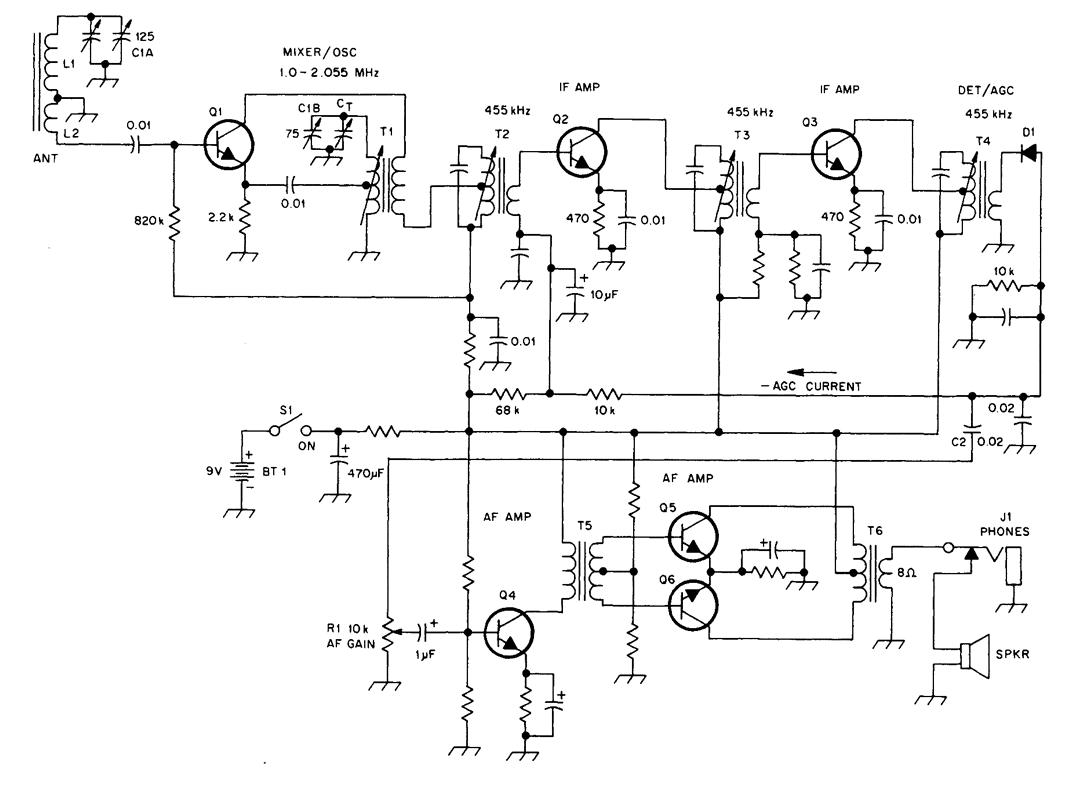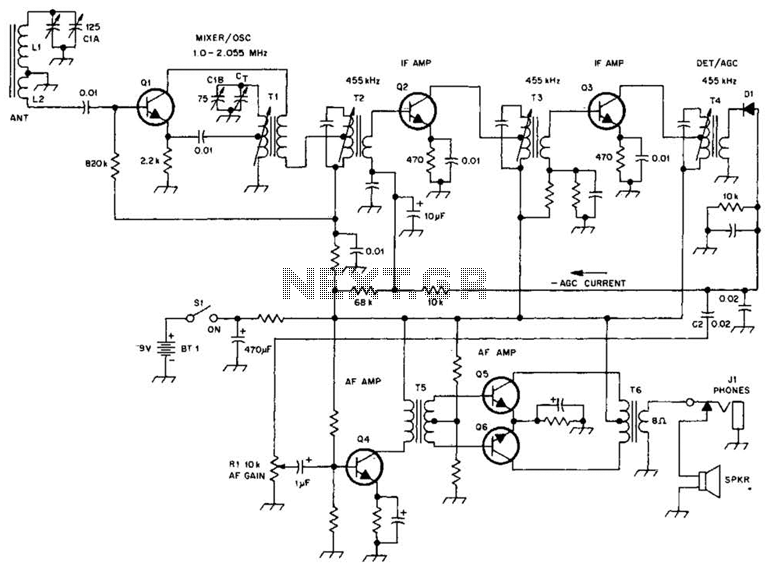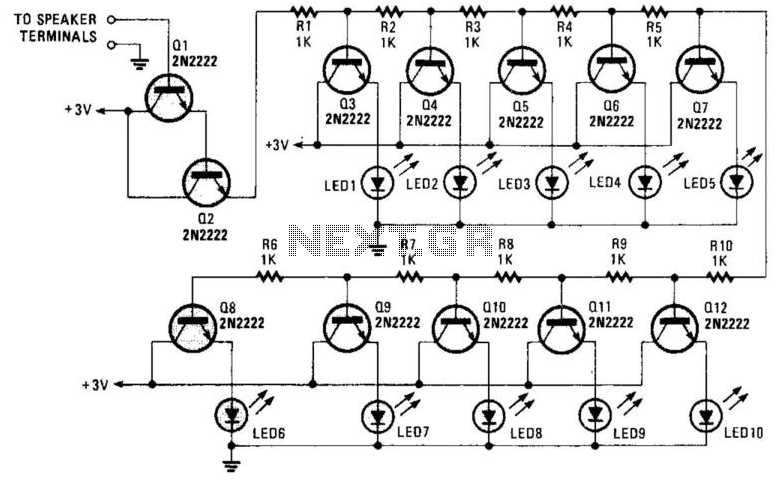
Transistorized flashers

Transistors Q1 and Q2 are configured as a free-running multivibrator. The output at the emitter of Q2 drives the base of the common emitter amplifier Q3, which controls the lamp. This circuit configuration allows for independent variation of flash duration, interval between flashes, and lamp type. Flash duration is proportional to the product of R2 and C2, while the off interval is proportional to the product of R3 and C1. Therefore, when precise flash timing is required, the tolerances of these components must be maintained within similar limits. The three circuits described are intended for barricade warning flasher lights commonly used in highway construction. They differ only in flash duration, which is typically set at 15%, 25%, or 50% of the flash rate.
Performance has been verified at ambient temperatures of -40°F, 77°F, and 212°F. A GE 5-volt, 90-milliampere type No. 1850 lamp is utilized.
The circuit operates based on the interaction between transistors Q1 and Q2, which are configured to form a multivibrator. In this arrangement, Q1 and Q2 alternately switch on and off, generating a square wave output at the emitter of Q2. This output signal is then used to drive the base of transistor Q3, which functions as a common emitter amplifier. The amplified output from Q3 is responsible for controlling the lamp, enabling it to turn on and off at the desired flash rate.
The timing characteristics of the multivibrator circuit are determined by the values of the resistors R2 and R3, and capacitors C2 and C1, respectively. The flash duration is influenced by the time constant created by R2 and C2, while the off interval between flashes is determined by the time constant of R3 and C1. This design allows for flexibility in adjusting the timing parameters independently, catering to various application requirements.
It is essential to maintain tight tolerances for R2, R3, C1, and C2, especially in applications where precise timing is critical. Variations in these component values can lead to inconsistent flash rates, which may not be acceptable in safety-related applications such as barricade warning flasher lights.
The circuit has been tested for reliable performance across a wide temperature range, ensuring functionality in extreme environmental conditions. The use of a GE 5-volt, 90-milliampere type No. 1850 lamp provides a standard illumination source, suitable for the intended application in highway construction zones. This lamp specification ensures adequate visibility while operating under various ambient conditions, contributing to the effectiveness of the warning system.Transistors Ql and Q2 are connected as a free running multivibrator. The output, at the emitter of Q2, drives the base of the common emitter amplifier Q3, which controls the lamp. This circuit configuration permits the flash duration, the interval between flashes, and the lamp type to be varied independently.
Flash duration is proportional to the product of R2C2 while the off interval is proportional to the product of R3C1. Consequently, when the flash timing must be accurately maintained, these component tolerances will have to be held to similar limits.
All three circuits described are designed for barricade warning flasher lights such as used in highway construction. They differ only in flash duration which normally is 15%, 25%, or 50% of the flash rate. Performance has been checked at ambient temperatures of -40°F, 77°F, and 212°F. A GE 5 volt, 90 milliampere type No. 1850 lamp is used.
Performance has been verified at ambient temperatures of -40°F, 77°F, and 212°F. A GE 5-volt, 90-milliampere type No. 1850 lamp is utilized.
The circuit operates based on the interaction between transistors Q1 and Q2, which are configured to form a multivibrator. In this arrangement, Q1 and Q2 alternately switch on and off, generating a square wave output at the emitter of Q2. This output signal is then used to drive the base of transistor Q3, which functions as a common emitter amplifier. The amplified output from Q3 is responsible for controlling the lamp, enabling it to turn on and off at the desired flash rate.
The timing characteristics of the multivibrator circuit are determined by the values of the resistors R2 and R3, and capacitors C2 and C1, respectively. The flash duration is influenced by the time constant created by R2 and C2, while the off interval between flashes is determined by the time constant of R3 and C1. This design allows for flexibility in adjusting the timing parameters independently, catering to various application requirements.
It is essential to maintain tight tolerances for R2, R3, C1, and C2, especially in applications where precise timing is critical. Variations in these component values can lead to inconsistent flash rates, which may not be acceptable in safety-related applications such as barricade warning flasher lights.
The circuit has been tested for reliable performance across a wide temperature range, ensuring functionality in extreme environmental conditions. The use of a GE 5-volt, 90-milliampere type No. 1850 lamp provides a standard illumination source, suitable for the intended application in highway construction zones. This lamp specification ensures adequate visibility while operating under various ambient conditions, contributing to the effectiveness of the warning system.Transistors Ql and Q2 are connected as a free running multivibrator. The output, at the emitter of Q2, drives the base of the common emitter amplifier Q3, which controls the lamp. This circuit configuration permits the flash duration, the interval between flashes, and the lamp type to be varied independently.
Flash duration is proportional to the product of R2C2 while the off interval is proportional to the product of R3C1. Consequently, when the flash timing must be accurately maintained, these component tolerances will have to be held to similar limits.
All three circuits described are designed for barricade warning flasher lights such as used in highway construction. They differ only in flash duration which normally is 15%, 25%, or 50% of the flash rate. Performance has been checked at ambient temperatures of -40°F, 77°F, and 212°F. A GE 5 volt, 90 milliampere type No. 1850 lamp is used.





